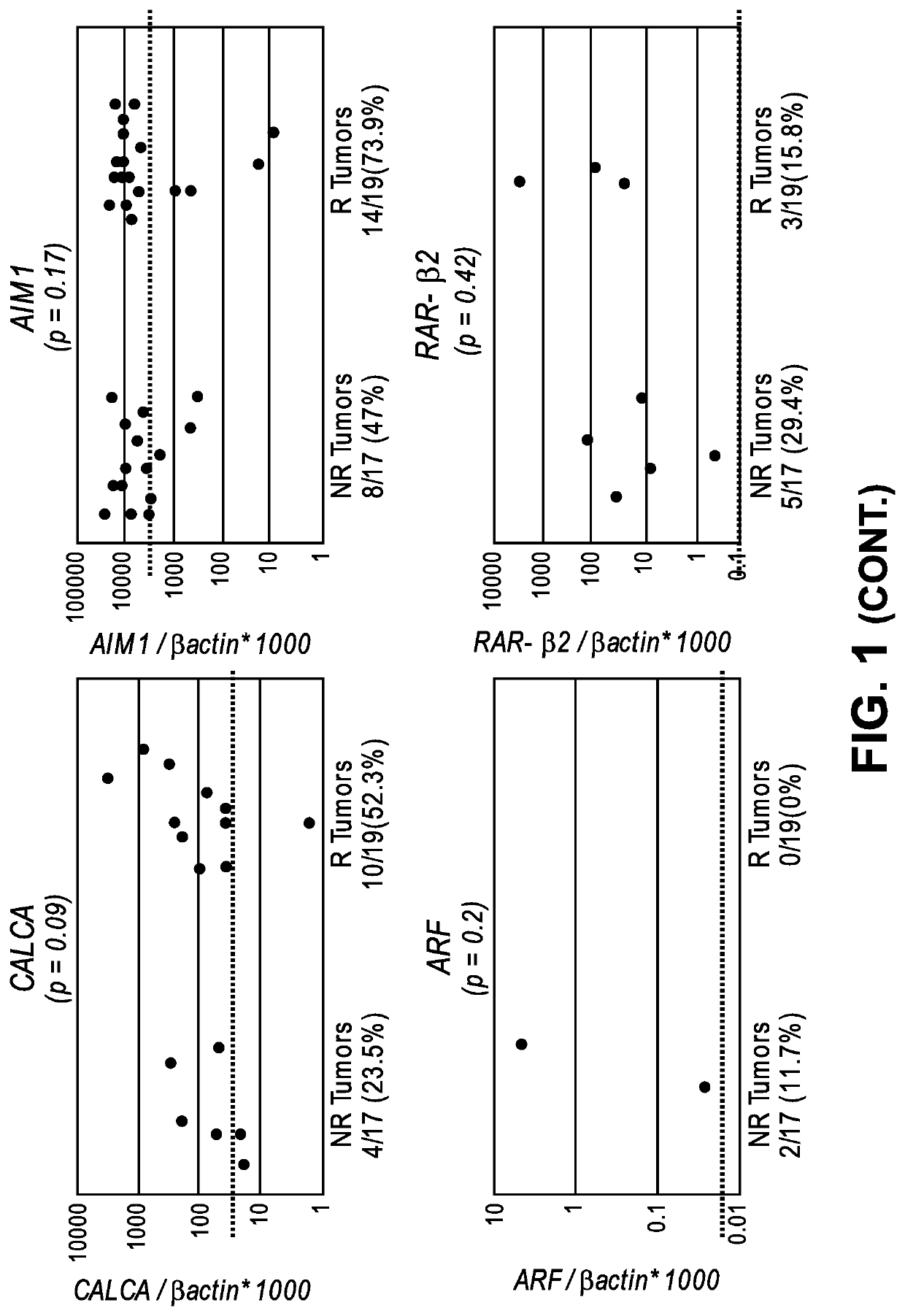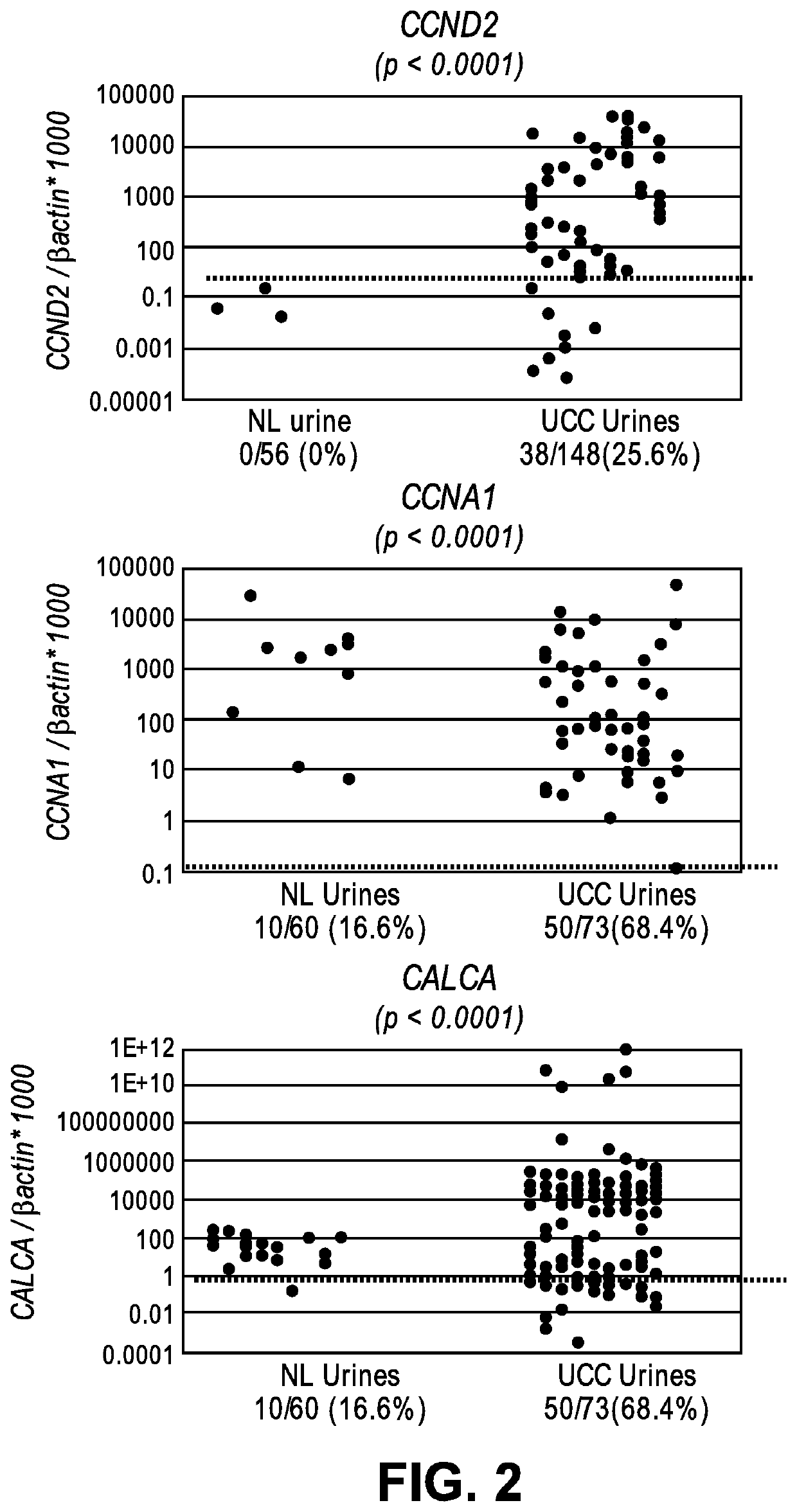Methods of detection and treatment of urothelial cancer
a technology of urothelial cancer and detection method, which is applied in the field of diagnostic and treatment of cancer to achieve the effect of improving symptoms and increasing expression
- Summary
- Abstract
- Description
- Claims
- Application Information
AI Technical Summary
Benefits of technology
Problems solved by technology
Method used
Image
Examples
example 1
Materials and Methods
[0079]Tissue and Urine Samples
[0080]A total of 36 formalin-fixed paraffin-embedded (FFPE) primary LGPUCC tissues were obtained from patients who underwent therapeutic surgery at The Johns Hopkins Hospital. The demographic and clinical information was obtained from the computerized tumor registry at The Johns Hopkins Healthcare System. Among the 36 LGPUCC samples, 17 were collected from patients who did not recur during any follow-up periods, and the remaining 19 were primary tumor samples that recurred within the follow-up periods after TURBT. We also performed analysis by considering the follow-up periods of 12, 18, and 24 months for recurrence to observe the association with promoter methylation of candidate markers.
[0081]To be included in the cohort, an eligible patient had to have a confirmed diagnosis of LGPUCC and a sufficient amount of archived tumor material for DNA extraction.To determine the feasibility of detecting promoter methylation of genes in uri...
example 2
Detection and Quantitation of DNA Methylation by PCR
[0103]Methylation at cytosine residues is effectively detected and quantitated by quantitative fluorogenic methylation specific PCR (QMSP). The assay is performed as described (see Maldonado, L. et al., Oncotarget, 2014, 5(14): 5218-5233). Briefly, DNA is extracted from cells isolated from a biological sample by phenol-chloroform extraction protocol followed by ethanol precipitation as described previously (Hogue, M. et al., J. Clin Oncol. 2005, 23(27): 6569-6575). Next it is subjected to bisulfite treatment, which converts unmethylated cytosine residues to uracil residues, as specified in the manufacturer's instructions (EpiTect Bisulfite kit, Qiagen), as previously described (Herman J G. et al., Proc Natl Acad Sci USA. 1996, 93 (18): 9821-9826). Bisulfite-modified DNA was used for fluorescence-based real-time PCR, as previously described (Hogue, M. et al., J Natl Cancer Inst. 2006, 98(14): 996-1004) Amplification reactions are ca...
example 3
Promoter Methylation Detection in UCC Tumor Tissue Samples
[0107]DNA is extracted from formalin fixed paraffin embedded (FFPE) block containing tumor tissue. A representative FFPE block, reviewed and confirmed to contain the pathologic sample is sectioned to obtain multiple 10 micron slides, several of which are used for microdissection to obtain portions containing greater than 70% of neoplastic cells. The first and last slides of the representative block are stained with hematoxillin and eosin.
[0108]By a candidate gene approach, promoter methylation of 8 genes (ARF, TIMP3, RAR-β2, NID2, CCNA1, AIM1, CALCA and CCND2) were analyzed by quantitative methylation specific PCR (QMSP) in the DNA of 17 non-recurrent and 19 recurrent noninvasive low grade papillary urothelial cell carcinoma archival tissues. A total of 36 FFPE primary low-grade papillary urothelial cell carcinoma (LGPUCC) tissue samples were obtained from patients who underwent therapeutic surgery. Among them 17 samples were...
PUM
| Property | Measurement | Unit |
|---|---|---|
| Fraction | aaaaa | aaaaa |
| Fraction | aaaaa | aaaaa |
| Fraction | aaaaa | aaaaa |
Abstract
Description
Claims
Application Information
 Login to View More
Login to View More - R&D
- Intellectual Property
- Life Sciences
- Materials
- Tech Scout
- Unparalleled Data Quality
- Higher Quality Content
- 60% Fewer Hallucinations
Browse by: Latest US Patents, China's latest patents, Technical Efficacy Thesaurus, Application Domain, Technology Topic, Popular Technical Reports.
© 2025 PatSnap. All rights reserved.Legal|Privacy policy|Modern Slavery Act Transparency Statement|Sitemap|About US| Contact US: help@patsnap.com



